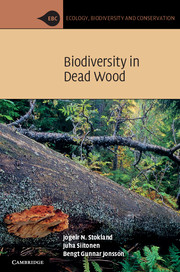Book contents
- Frontmatter
- Contents
- Preface
- 1 Introduction
- 2 Wood decomposition
- 3 The saproxylic food web
- 4 Other associations with dead woody material
- 5 Host-tree associations
- 6 Mortality factors and decay succession
- 7 Microhabitats
- 8 Tree size
- 9 The surrounding environment
- 10 Evolution of saproxylic organisms
- 11 Species diversity of saproxylic organisms
- 12 Natural forest dynamics
- 13 Dead wood and sustainable forest management
- 14 Population dynamics and evolutionary strategies
- 15 Threatened saproxylic species
- 16 Dead wood in agricultural and urban habitats
- 17 The value and future of saproxylic diversity
- References
- Index
11 - Species diversity of saproxylic organisms
Published online by Cambridge University Press: 05 June 2012
- Frontmatter
- Contents
- Preface
- 1 Introduction
- 2 Wood decomposition
- 3 The saproxylic food web
- 4 Other associations with dead woody material
- 5 Host-tree associations
- 6 Mortality factors and decay succession
- 7 Microhabitats
- 8 Tree size
- 9 The surrounding environment
- 10 Evolution of saproxylic organisms
- 11 Species diversity of saproxylic organisms
- 12 Natural forest dynamics
- 13 Dead wood and sustainable forest management
- 14 Population dynamics and evolutionary strategies
- 15 Threatened saproxylic species
- 16 Dead wood in agricultural and urban habitats
- 17 The value and future of saproxylic diversity
- References
- Index
Summary
It is evident that planet Earth hosts several million species. The actual number of species is unknown but a much cited study has calculated a global figure of 12.5 million species (Hammond, 1992), while a recent detailed revision came close to 11 million species (Chapman, 2009). In addition to these calculations, there are also estimates that have arrived at global figures as high as 30–100 million species (Erwin, 1982). Nobody has tried to estimate the number of saproxylic species on a global scale. This is quite understandable, since many groups are poorly investigated and large areas are minimally explored for wood-inhabiting species. But there is one region where most saproxylic species are well documented – in the Nordic countries of Europe. We therefore highlight some of this knowledge and present an overview of the diversity in various groups. Despite major knowledge gaps on a global scale, we also make an attempt to calculate the relevant numbers indicating the global diversity of saproxylic species.
Saproxylic diversity in northern Europe
There is a long and strong tradition of documenting species diversity in the Nordic countries of Sweden, Finland, Denmark and Norway. This tradition is rooted in the work of Carl von Linné, who made Sweden the European centre for alpha-taxonomy (i.e. the description of new species) in the 1700s. The Linnean school also had a great local impact in Sweden and the neighbouring countries. During the 1700s and 1800s, the majority of terrestrial species in the Nordic region were described and identification keys were made for large groups of insects and fungi.
- Type
- Chapter
- Information
- Biodiversity in Dead Wood , pp. 248 - 274Publisher: Cambridge University PressPrint publication year: 2012
- 13
- Cited by



